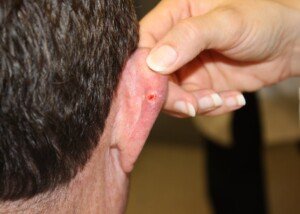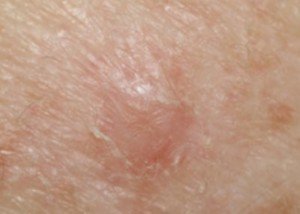If pimples are supposed to be some shade of pink or flesh colored, then what causes a pimple to be purple?
Being that skin cancer can come in many different colors, one has to wonder if a skin cancer such as melanoma can somehow get involved with a common blemish and turn it purple.
Purple Pimples
“That purple tint you see is one thing: blood,” says Bobby Buka, MD, a NYC dermatologist and CEO of The Dermatology Specialists, and author of “Buka’s Emergencies in Dermatology” and “Top 50 Dermatology Case Studies for Primary Care.”
Dr. Buka explains, “Some pimples can be highly inflamed, which means greater blood flow beneath the spot that will cause a purplish appearance.
If you’ve squeezed the pimple, that can create minor tissue bruises beneath it which will also result in a purple tint.”
The blood causes a purple color because it’s beneath the pimple rather than on the exterior.
Can a Purple Pimple Actually Be Cancer?
“No, this does not indicate a melanoma or any other type of skin cancer,” says Dr. Buka.
However, beware of pink, reddish or flesh colored pimples that don’t go away after two weeks. If such a lesion is still around after three weeks, it is not a common harmless blemish.
- The life cycle of a true pimple lasts only a few weeks.
- Then it’s gone.
- You may keep getting them all over your face, but each individual one will be gone in a few weeks.
Anything that looks like a pimple but does not go away, or if it seems to start clearing up but then returns (repeating this process over and over), you’d better have a dermatologist examine it.
This doesn’t mean it’s cancer, but cancer needs to be ruled out.
Though sometimes a skin cancer can contain pigments of purple, especially in more advanced stages, the topic here is the resemblance to a common pimple rather than something that looks like a mole or ulcer.
Amelanotic melanoma, though not purple, can strongly resemble a pinkish or flesh colored pimple. Its prognosis is worse than that for the more common type of melanoma that’s usually dark and flat.
 Dr. Buka is the contributing Founder and Chief Science Officer of the First Aid Beauty skin care line. firstaidbeauty.com
Dr. Buka is the contributing Founder and Chief Science Officer of the First Aid Beauty skin care line. firstaidbeauty.com
 Lorra Garrick has been covering medical, fitness and cybersecurity topics for many years, having written thousands of articles for print magazines and websites, including as a ghostwriter. She’s also a former ACE-certified personal trainer.
Lorra Garrick has been covering medical, fitness and cybersecurity topics for many years, having written thousands of articles for print magazines and websites, including as a ghostwriter. She’s also a former ACE-certified personal trainer.
.



























